 Vampire Weekend's Surprising Jewish Stories
Vampire Weekend's Surprising Jewish Stories
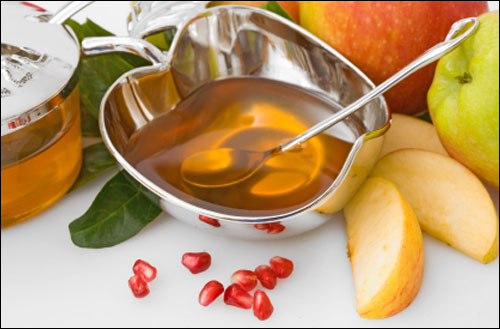

4 min read
3 min read
7 min read
9 min read
Favorite ways to enjoy the symbolic foods on Rosh Hashanah.
Rosh Hashanah is a time for praying, family, and with a three-day Yom Tov, also a time for eating. We are given the opportunity to make special blessings with symbolic foods (simanim). Many people ask me how to incorporate these foods into their meal. Here are a few favorite ways that we enjoy the simanim.
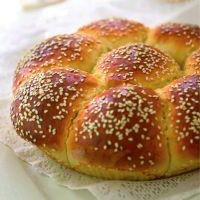
Makes 2 loaves, but can be doubled
For the glaze:
In a large bowl, mix the yeast with ½ cup of the flour and 1 teaspoon sugar. Add the warm water, stir, and let this mixture, called a sponge, sit until it starts to puff up, 15-to 20-minutes. Add the eggs, oil, honey, and salt; stir until well combined. The sponge will remain lumpy—this is fine. Add the remaining flour and mix the dough in the bowl until all the ingredients are combined. Turn the dough out onto a work surface and knead until fairly smooth, about 2 minutes. The dough should feel very firm and will be hard to knead. If it’s soft and sticky, add more flour until it’s very firm. Transfer the dough to a large, clean container and cover it well. Let it rise until doubled in bulk and very soft to the touch, about 2 hours.
Braid and let rise an additional 1 – 2 hours.
Position an oven rack in the lower third of the oven and heat the oven to 325°F. Make the glaze by whisking with a fork, the egg, honey and vanilla. Just before baking, brush the dough with the glaze. With a thin wooden skewer, poke the bread deeply all over (the holes will prevent air pockets and help the bread keep its shape during baking). Bake for 20 minutes. Rotate the challah 180 degrees and bake until the bread is a dark, burnished brown, about another 15 minutes. (If the challah is browning too rapidly cover it loosely with foil and let it finish baking. Don’t remove the loaf too soon, as you’ll risk under-baking.) Let cool thoroughly on a rack.
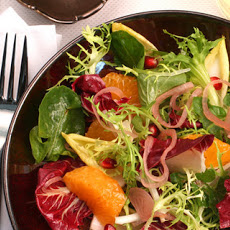
Serves 4
Whisk together dressing ingredients or use hand blender and toss with all salad ingredients.
S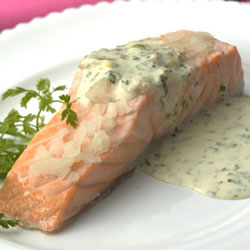 erves 8-12
erves 8-12
Dill sauce:
Combine cinnamon stick, bay leaves, vinegar and sugar in a container large enough to hold the fish. Add fish and enough water to just cover the fish. Marinate in refrigerator overnight.
Remove fish and pour marinate into pot. Add 2 onions and pickling spice and more water, if necessary, so that fish will be covered when added to pot. Bring to a boil and simmer for ½ hour, covered. Add fish and continue cooking for about 10 minutes or until done. Allow to cool slightly and remove fish carefully.
Put fish into container and pour the cooked marinade through a strainer over fish. Refrigerate. Put mayonnaise, pickle, sugar, ketchup, scallions and dill into blender with water. Blend. Add more water if needed to make a thick sauce. Serve sauce over cold fish.
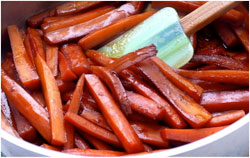
Serves 4
In a large saucepan, bring about 1 quart of salted water to a boil. Add the carrots, blanch for about 2 minutes, and drain. Heat the olive oil in a large sauté pan over high heat until smoking hot. Add the carrots and allow them to sit in the pan to sear, 2 to 5 minutes or until brown. Toss the carrots and sear again. Add the garlic and shallots and briefly sauté. Add the balsamic vinegar and reduce over high heat until thick and carrots are coated, about 2 minutes. Add the marjoram and season to taste with salt and pepper. Serve piping
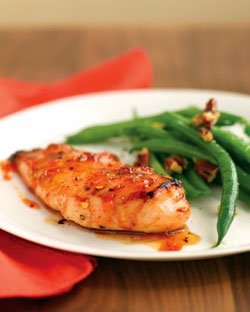
Serves 4
This is a sweet dish for a sweet New Year. This Rosh Hashanah recipe can be made a day or two ahead of time and reheated before serving.
Soak dried apricots in cider until plump. Transfer apricots and cider to blender. Add canned apricots with their liquid, and whirl to puree with some chunks. Set aside. Heat oil in medium skillet over medium-high heat. Brown chicken breast on both sides, 8 minutes, turning after 4 minutes. Transfer chicken to plate. Add shallots to pan and cook until lightly browned, 2 minutes. Add broth and juice and scrape up browned bits in pan. Add rosemary, chili powder and sugar. Return chicken to pan and simmer until cooked through, 6 to 8 minutes. Serve chicken with generous amount of sauce.

Serves 8
Preheat an oven to 350 degrees F.
In a large pot, heat the canola oil over high heat. When the oil begins to smoke slightly, season both sides of the brisket with salt and pepper, to taste. Use metal tongs to add the meat to the pot. If the oil is hot enough, the meat will not stick to the bottom. Cook, undisturbed, on its first side until browned, about 3 to 5 minutes. Turn over and brown on the other side, about 3 to 5 additional minutes. Remove the meat from the pot and put it onto a baking sheet to rest.
Combine the garlic paste and green onions in a small bowl. Spread half of the mixture over the brisket. Flip the meat and add the remaining mixture to the other side. Set aside.
In the same pot, over low heat and add the parsnips. Season them with a little salt and a 1 tablespoon brown sugar. Stir to coat with the oil and cook until slightly tender, about 2 to 3 minutes. Add in 2 tablespoons apple cider vinegar and the leeks and gently brown them, about 3 to 5 minutes. Adjust the seasonings with salt. Pour in the wine and let it reduce for 5 minutes. Sprinkle the vegetables with the remaining ¼ cup of brown sugar and another pinch of salt. Cook them until browned, another 3 to 5 minutes.
Add the brisket to the pot and stir in 2 to 3 cups of the beef stock. Bring the stock to a gentle simmer. Slide it into the center of the oven and cook for 1 hour. Check the level of the liquid, adding water, if needed. Remove the pot from the oven, taste and adjust seasonings if needed. Return the pot to the oven and cook the brisket until the meat is tender when pierced with a fork, an additional 1 to 1 ½ hours. (Chef's Note: If the meat looks dry or begins to overly brown, cover the pot with a lid or a layer of aluminum foil for the remainder of the cooking process.)
Remove the pot from the oven and transfer the meat to a platter. Arrange the vegetables alongside and ladle the sauce on top. Make this at least one day ahead of time.

Makes 16
Preheat oven to 350°F. Butter 8×8-inch metal baking pan. Bring 1 ½ cups water to simmer in medium saucepan. Add dates; simmer until very soft and thick, stirring occasionally, about 10 minutes. Cool to room temperature. Stir in vanilla.
Combine flour, sugar, oats, cinnamon, baking soda and salt in large bowl; stir to blend. Add margarine. Using fingertips, rub in until moist clumps form. Press half of oat mixture evenly over bottom of prepared pan. Spread date mixture over. Sprinkle with remaining oat mixture; press gently to adhere. Bake until brown at edge and golden brown and set in center, about 40 minutes. Cool completely in pan on rack. Cut into bars and serve.
